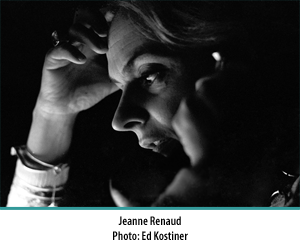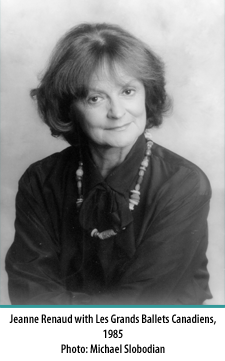| ||||||

 In spite of her early and public complaints about granting agencies in Quebec and Canada, Jeanne Renaud was recognized as a person with valuable practical experience needed to complement the administrative knowledge of the Canada Council's career employees. This was also true of fellow arts activists such as Claude Gosselin and René Blouin, who became her close friends at the Canada Council, all working to assure that contemporary art in various media was understood and given its due by the Council. Jeanne Renaud's first assignment in Ottawa was to review applications from individual artists in dance and music. She hoped to bring more attention to dance and especially to contemporary choreographers, but the people around her knew very little about anything but classical ballet, and the juries habitually offered assistance to a small circle of names.
In spite of her early and public complaints about granting agencies in Quebec and Canada, Jeanne Renaud was recognized as a person with valuable practical experience needed to complement the administrative knowledge of the Canada Council's career employees. This was also true of fellow arts activists such as Claude Gosselin and René Blouin, who became her close friends at the Canada Council, all working to assure that contemporary art in various media was understood and given its due by the Council. Jeanne Renaud's first assignment in Ottawa was to review applications from individual artists in dance and music. She hoped to bring more attention to dance and especially to contemporary choreographers, but the people around her knew very little about anything but classical ballet, and the juries habitually offered assistance to a small circle of names.
In order to broaden the field of applicants, Jeanne Renaud invited young choreographers to talk to her, assisted them with their applications, and spoke for them in Canada Council circles. But it was frustrating work, and after two years, looking for a change of atmosphere, at the invitation of René Blouin, she joined the new Explorations Program of the Canada Council, which provided grants for all artistic disciplines and was open to people who were not necessarily well established in a discipline. Jeanne Renaud's assigned areas were Quebec and the Maritimes. In an article from the Cape Breton Post, dated August 4, 1978, she is identified as Chair of the regional committee and is quoted explaining the role of Explorations grants, while regretting the limited budget, and the fact that from about fifty-five applicants only twelve or thirteen would be chosen to receive funding. She later talked about having worked hard to follow up on lapsed applications and to keep in contact with possible recipients of grants. She became acutely aware of having to make difficult choices between, for example, large established companies and small experimental ones. She was with the Canada Council from 1975 to 1979, the last eighteen months with Explorations. These four years in Ottawa came to an end when the Quebec Ministry of Culture hired her away from the Canada Council, convinced that, with her established name and experience, she could help them get more financial backing for dance.
 Thus, it was as a representative of the Government of Quebec that Jeanne Renaud took part in a panel discussion, along with video artist John Faichney and filmmaker Peter Dudar, on “The Social and Political Role of the Artist in Society” during the 7th Dance in Canada Conference, held in Waterloo, Ontario, on July 1, 1979. This resulted in what may be the first of a series of important written statements about dance and the arts that Jeanne Renaud produced over the following years, and it contains some key concepts: that a genuine artist is dealing with the “not yet known” and should not expect to be understood immediately; that, consequently, artists need a buffer to help protect them from both entrenched and rapidly changing popular tastes, and from the vagaries of arts funding; that the education of dancers should impart knowledge not only of past and contemporary dance scenes, but of the other arts as well, stimulating “the interaction of dance with the other artistic disciplines.” In the same text, she calls for increased communication and interaction between regional and national arts organizations, noting that dance has been badly served by historians, critics, and by the new electronic media. “The whole notion of documentation and evaluation of dance has become a crucial area,” she wrote. “There is, in fact, a real need for a more precise and cohesive documentation in all formats (writing, film, video, photography, etc.). And this, not only for archival purposes but also for development of a critical awareness of the work and the promotion, for improvement of communications, and general promotion in regional and international arts centres.” In conclusion, she confesses to not having easy solutions about “the potential means to arrive at a sounder financial base, relying on public and private funds without compromising the quality of the work, without endangering the very genuine process of creation, without confining it exclusively to marketing and commercial devices.” Note how pertinent these observations are to debates going on currently.
Thus, it was as a representative of the Government of Quebec that Jeanne Renaud took part in a panel discussion, along with video artist John Faichney and filmmaker Peter Dudar, on “The Social and Political Role of the Artist in Society” during the 7th Dance in Canada Conference, held in Waterloo, Ontario, on July 1, 1979. This resulted in what may be the first of a series of important written statements about dance and the arts that Jeanne Renaud produced over the following years, and it contains some key concepts: that a genuine artist is dealing with the “not yet known” and should not expect to be understood immediately; that, consequently, artists need a buffer to help protect them from both entrenched and rapidly changing popular tastes, and from the vagaries of arts funding; that the education of dancers should impart knowledge not only of past and contemporary dance scenes, but of the other arts as well, stimulating “the interaction of dance with the other artistic disciplines.” In the same text, she calls for increased communication and interaction between regional and national arts organizations, noting that dance has been badly served by historians, critics, and by the new electronic media. “The whole notion of documentation and evaluation of dance has become a crucial area,” she wrote. “There is, in fact, a real need for a more precise and cohesive documentation in all formats (writing, film, video, photography, etc.). And this, not only for archival purposes but also for development of a critical awareness of the work and the promotion, for improvement of communications, and general promotion in regional and international arts centres.” In conclusion, she confesses to not having easy solutions about “the potential means to arrive at a sounder financial base, relying on public and private funds without compromising the quality of the work, without endangering the very genuine process of creation, without confining it exclusively to marketing and commercial devices.” Note how pertinent these observations are to debates going on currently.
During a conference at the University of Sherbrooke, held October 18, 1980, Jeanne Renaud presented a 5,000-word paper on the history of dance in Quebec, obviously much informed by the work she had been doing for the province's Ministry of Cultural Affairs. It is a far-reaching history, going back to the earliest times and up to the present, with brief accounts of contemporary work. But a major part of the report is a lengthy and fascinating account of folkloric dance in Quebec, which flourished (relatively) because it was the only kind acceptable to the clergy even into the 1930s and beyond. In the dossier concerning her work for the Ministry, there are reports by Jeanne Renaud on such matters as jury formation and the financial needs of dance companies throughout the province. This work was all part of her expected duties to set up a new program of assistance specifically for dance, but when the promised budget failed to materialize (most of it having been devoted to classical ballet), she had just enough money to establish a few grants for young creators. Since no one else seemed to know how to accommodate unusual types of performance, she found herself giving their first grant to an unknown group called Cirque du Soleil. Billed as a “dance consultant to the Quebec government,” she also took part, along with an impressive list of people from across the country, in a conference sponsored by Simon Fraser University, on Granville Island in Vancouver: “A conference for artists, arts policy-makers, administrators, and educators, which will investigate what artists are doing and their part in the re-FORMation that is not well understood.” This was held August 10-13, 1982.
In 1981, the Quebec Ministry had sent Jeanne Renaud to Montreal to the Conservatory of Music and Theatre with the intention of having her teach movement to theatre people. When the theatre union objected to this intrusion, the Ministry had her do an inventory of dance teaching in the province, an extensive piece of documentary work that has never been published in any form. But during this period, she was approached by the Université du Québec à Montréal (UQAM) seeking ideas for their new program in the arts. Excited by her interdisciplinary suggestions, they were able to hire her, first on loan from the Ministry of Cultural Affairs, and then through the office of the Associate Dean of UQAM. The appointment was to be until May of 1984. Hired as a special consultant to the Associate Dean, her mandate was to report on the programs leading to a Master's Degree in Arts, and to construct a hypothetical model for an interdisciplinary program involving arts education - visual arts, drama, dance and music. Her archives include a forty-page report on this projected interdisciplinary certificate program for UQAM, submitted in February 1984. It was never adopted. In that same month, she was named to the administrative council of the Museum of Contemporary Art in Montreal. In September 1985, she wrote an eleven-page text to introduce five choreographers from Quebec - Jean-Pierre Perreault, Paul-André Fortier, Édouard Lock, Marie Chouinard and Ginette Laurin - to the Festival international de nouvelle Danse, held in Montreal that year. It was never published, but it is an admirable capsule summary of tendencies in contemporary dance in Canada. She also gave a very short introduction to new Canadian dance entitled “The Young Montrealers” at a conference in London while Les Grands Ballets Canadiens were giving a show in Covent Garden. And as another example of her public presence as an authority on Canadian dance, there is her participation at the Dance in Canada conference, Dance on Track 86 Danse entr'acte, held in Vancouver August 11-17, 1986. Jeanne Renaud participated in two panel discussions, for one of which, on August 15, she prepared a paper entitled “Artistic Vision for Canada's Major Ballet Companies”. This and other papers reflect work she had done for the Canada Council and the Quebec ministry. They are worthy of publication in their own right.
©2009, Dance Collection Danse
Jeanne Renaud Exhibition Curators: Ray Ellenwood and Allana Lindgren
Web Design: Believe It Design Works

